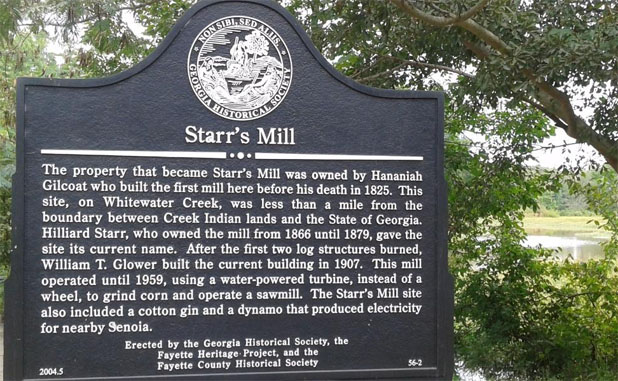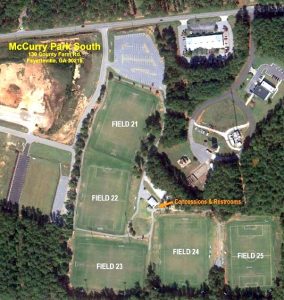The Fayette County Board of Commissioners could decide this month how to regulate development in the years to come next to one of the county’s most recognizable structures.
Under consideration right now is a series of resolutions that would create an historic overlay district for the area surrounding the intersection of Hwy. 74, Hwy. 85 and Padgett Road, the area in front of Starr’s Mill.
Implementing changes would involve amending the Future Land Use Map and several zoning ordinances involving what kinds of development can occur and how it would look.
The project was initiated in response to a request from property owners at the intersection and along the widened four-lane stretch of Hwy. 74, according to officials.
Also under consideration is a proposed color and brick palette for the overlay district. All of the proposed ordinance changes have been recommended for approval by the Planning Commission and county staff.
County Zoning Director Pete Frisina told the commissioners that the process started several years ago when local residents wanted the county to take a look at the intersection, but officials did not want to do much before the Hwy. 74 widening, which was completed about two years ago. The substantive work began in July of 2015 and included the Planning Commission.
The affected property is zoned for residential use, and planners are looking at limited-use commercial and office-institutional for the area, aiming to match the area’s historic nature.
“Starr’s Mill one of the most iconic images in county,” said Frisina. “It is also considered the southern gateway for the county.”
Commissioner Steve Brown took that assessment even farther.
“If you Google ‘Fayette County Georgia’ under the Images function, you get two pages of Starr’s Mill photos,” said Brown. “It is the most recognizable image in Fayette County, historic or otherwise.”
A local resident who said he has been there 45 years inquired about the possible uses for the property, including his if he decides to sell it. A few options were mentioned among the two tiers of limited-commercial zoning possible at the site.
One such possible use was a gas station, and Brown said he would “passionately oppose” that. While complimenting the board on what he called a “great job” managing historic locations elsewhere in the county in recent years, he said he was in favor of an historic overlay district and wanted the board to focus more on what should not be developed on the site.
“I’d rather we list five or ten things we definitely do not want there,” he said. “I would love to see office-institutional there with an historic overlay look. But I’m going in kicking and screaming if we put a gas station next to that historic site.”
When asked by Chairman Charles Oddo about the possibilities in that regard, Frisina said the current ordinance is a “permissive use ordinance” that outlines what can be allowed for each category.
“Anything not listed is not permitted,” said Frisina. “You can go through any of it and take something out.”
County Attorney Dennis Davenport said that an overlay district is a good opportunity for identifying non-permitted items, but the county could not discriminate regarding uses at various sites in the same regular zoning district.
A motion was approved unanimously by the board to send the proposed ordinance changes back for further reworking by county staff and present again at the June 23 regular meeting.












Leave a Comment
You must be logged in to post a comment.